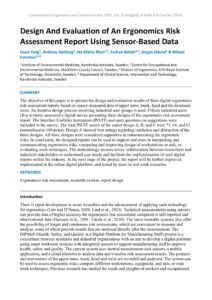| Document | Author Liyun Yang1, Andreas Hallberg2, Ida-Märta Rhen1,2, Farhad Abtahi3,4, Jörgen Eklund1 & Mikael Forsman1,2,3 |
| Abstract The objective of this paper is to present the design and evaluation results of three digital ergonomics risk assessment reports based on sensor-measured data of upper arms, trunk, head and the dominant wrist. An iterative design process involving industrial user groups is used. Fifteen industrial users (five women) answered a digital survey presenting three designs of the ergonomics risk assessment report. The Interface Usability Instrument (INUIT) and open questions on suggestions were included in the survey. The total INUIT scores of the report design A, B, and C were 71, 64, and 61 (normalised to 100 point). Design A showed best ratings regarding confusion and distraction of the three designs. All three designs were considered supportive in communicating the ergonomic risks. In conclusion, the designed reports can be used to support end users in interpreting and communicating ergonomics risks, comparing and improving design of workstations or aids, or evaluating work techniques. The methodology ensures active collaboration between researchers and industrial stakeholders to understand user needs and facilitate the implementation of such digital reports within the industry. In the next stage of the project, the report will be further improved, implemented in the online digital platform, and tested by users in real work scenarios. |

